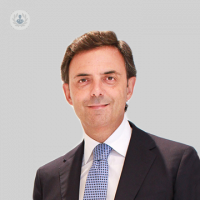An expert's guide to cataracts
Written in association with:Sight is a precious gift, allowing us to see and experience the world around us. However, there are many problems and diseases that can affect our eyes. Cataracts are one such eye condition that can rob us of our sight. What are cataracts? What causes them, and why remove them? We talked to expert Mr Vincenzo Maurino, a leading ophthalmologist and authority on cataract surgery, who provides the answers.

What causes cataracts?
Well, the first thing is to explain what a cataract is. Inside the human eye, which works like a camera, there are two lenses. One is the cornea. One is the crystalline lens. The crystalline lens allows us to focus and see things close up without glasses. It’s completely transparent. It is suspended at the center of the eyeball by some very fine ligament. With time, the lens loses transparency and that’s the main cause of cataract formation: age.
Normally, a cataract starts forming at the age of 50-60 when the lens starts to become a little less transparent and then as the patient ages further, it starts affecting the quality of the vision itself and requires removal.
However, there are other causes:
- Retinal detachment surgery can increase the cataract formation rate.
- Inflammatory eye conditions, such as chronic uveitis (an inflammation of the inside of the eyes) can cause cataract formation earlier in life.
- Trauma to the eye, be it minor or major, can cause early cataract formation. Cataracts in our young patients are quite often because of minor or major traumas.
- Less commonly, one cause of cataract formation can be genetic; a family history of cataracts and in those cases, they usually happen either at birth or later in life, but still before the age of 40.
How can you prevent cataracts from getting worse?
It is actually very difficult to stop cataracts getting worse, in the sense that it’s a little bit like everything else that we do in life. Having a healthy lifestyle is what can prevent cataract formation. Avoid excessive sunlight exposure by wearing sunglasses.
Ultimately, trying to prevent cataract formation is not a big issue because removal of the cataract will give most patients 99% perfect vision, with the added benefit of reducing of their dependence on glasses and most patients nowadays view cataract surgery as a means not only to see better, but also to improve their lifestyle by tremendously increasing their independence from glasses.
Why remove cataracts?
Basically, there are two reasons to remove cataracts.
- The primary reason is so we can see better. The cataract will affect vision to a certain degree and we will want the cataract removed to continue living our lives to the full, without being hindered by poor vision. When we remove the cataract can differ from one patient to another, but ultimately, the cataract will need removal to restore sight.
- One beneficial side-effect to removing the cataract for people who wear glasses is that dependence on spectacles can be almost fully eliminated. We can use special monofocal lenses to give the patient good distance vision or for near sight, depending on their preference. Nowadays, there are also some very technologically advanced trifocal lens that allow the vast majority of our patients to see well for any given distance after the cataract surgery. Imagine going skiing – if you’re very short-sighted, it’s quite difficult, but after cataract surgery, people can enjoy even a more active lifestyle than before.
Find out more about cataract surgery in the second part of this interview.



